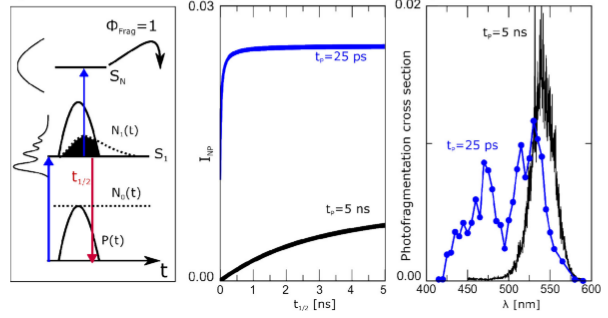
Complex photophysics requires complex theory.
Alex Kulesza, Steve Daly, Chang Min Choi, Luke MacAleese, Rodolphe Antoine and Philippe Dugourd (team SpectroBio), in collaboration with colleagues from Potsdam University in Germany, have published an article entitled « Excited States of Xanthene Analogues: Photofragmentation and Calculations by CC2 and Time-Dependent Density Functional Theory » in the journal ChemPhysChem. This paper was selected for cover.
This study stems from the unexpected experimental observation that the photo-fragmentation of the same dye yields markedly different optical spectra with nanosecond and picosecond lasers. To understand the photophysics of the dyes we had to go beyond the picture of vertical absorption and had to use theoretical methods more involved than the popular ones. Only the combination of accurate excited-state energy prediction by CC2 and including the excited-state dynamics considerations was finally successful to explain the measurements.
11/10/2016


Quelle approche théorique pour une photophysique complexe?
Alex Kulesza, Steve Daly, Chang Min Choi, Luke MacAleese, Rodolphe Antoine et Philippe Dugourd (équipe SpectroBio), en collaboration avec des collègues de l’université de Potsdam en Allemagne, ont publié un article intitulé « Excited States of Xanthene Analogues: Photofragmentation and Calculations by CC2 and Time-Dependent Density Functional Theory » dans la revue ChemPhysChem. Cet article a été sélectionné pour faire la couverture de la revue.
Cette étude trouve ses origines dans l’observation inattendue de profondes différences dans les spectres de photo-fragmentation en phase gazeuse de colorants selon qu’on utilise un laser à impulsions courtes (picoseconde) ou un peu plus longues (nanoseconde). Pour comprendre la photo-physique à l’œuvre il a fallu dépasser la représentation simpliste de la fragmentation égale à l’absorption, et utiliser des méthodes de calcul nettement plus poussées qu’à l’ordinaire. Seuls le calcul précis (method CC2) des niveaux énergétiques des états excités, en combinaison avec la prise en compte de la dynamique à l’état excité permet de proposer une explication de ces observations.
11/10/2016


















